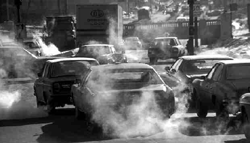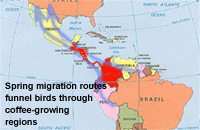
(See related pages)
Enviormental Concerns in the "Battle For Seattle," at World Trade Organization Talks Environmental Concerns in the "Battle For Seattle," at World Trade Organization Talks December, 1999 Seattle, Washington The "Battle for Seattle" received extensive media coverage in late November and early December, 1999, when protesters demonstrated at the World Trade Organization (WTO) meeting in Seattle. Tens of thousands of protesters gathered in Seattle streets, blocking the opening sessions of the WTO meeting, and police and national guard forces used tear gas and rubber bullets to subdue protesters. The protesters gathered to bring attention to many grievances against the WTO, including labor rights and the closed-door decision making process. Also angering protesters at the WTO meeting were environmental concerns-should the WTO be able to undermine clean air legislation, or outlaw turtle-safe shrimp or dolphin-safe tuna? Environmentalists fear that the WTO will gradually lower all the world's environmental standards to the lowest level, forcing many countries to go back on the environmental gains they have made in recent decades.
The World Trade Organization is a body of representatives from corporations based in the world's major trading nations. Nations that are members of the WTO give rights to the organization to make decisions that will ensure free movement of goods and money between countries. The WTO facilitates trade by forcing member nations to reduce taxes on traded goods, to remove rules blocking trade, and to reduce subsidies that give "unfair" advantages to domestic corporations, thereby disadvantaging foreign producers of trade goods. The justification of this power is that free movement of capital makes everybody wealthier, and therefore happier. Countries frequently appeal to the WTO to reduce labor and environmental regulations that act as "barriers" to trade. For example, the United States' clean air laws require the use of relatively clean-burning gasoline, to reduce pollution associated with low-grade fuels. In one of the first appeals to the WTO, Venezuela and Brazil argued that the clean gasoline legislation was a trade barrier, preventing the sale of lower quality Venezuelan gas in the US. The WTO agreed, and the US has been forced to roll back related clean air legislation. Similarly, the US banned the import of shrimp from countries that refused to ensure that endangered sea turtles were not being wantonly destroyed by shrimp nets. Several shrimp exporting nations appealed to the WTO, arguing that the turtle-friendly shrimp ban was an obstruction to trade. Last year the WTO agreed, overturning the US legislation and forcing the US to allow shrimp imports regardless of sea turtle mortality. The US has also appealed to the WTO to reduce environmental and health trade barriers. Most notably, European countries have restricted the sale of genetically modified agricultural products and beef treated with growth hormones. These laws have been instituted at the insistence of consumers who distrust the environmental and health effects of genetically engineered soy beans, corn, wheat, milk, and other products. On behalf of American genetic engineering corporations, the US is suing the European Community to drop these barriers and open European markets to genetically modified food products. The long-term effects of WTO decisions on the environment, labor, and society remain to be seeen, as do the impacts of environment and labor protesters at the WTO. It is important, however, that citizens understand the implications of these international bodies on local conditions-beneficial as well as detrimental. The protests in Seattle have helped bring some national attention to these powerful, often unobserved, processes. To read more, see Environmental Science, A Global Concern, Cunningham and Saigo, 5th ed.
Environmental Science, Enger and Smith, 6th ed. For further information, see these related web sites: Environmental Media Services review of Environmental the WTO protests
Why You Should Buy Organic Coffee: It Helps Migratory Birds and Other Forest Species September, 1998
Coffee beans are really seeds from berries that grow on shade-loving understory bushes. These bushes need the shade of mature trees, the same trees that provide habitat and food for many birds and insects. Across Central America and other coffee-growing regions, birds, bats, butterflies, and other forest-dwelling species, have found shelter in the open forests of coffee plantations at the same time as local farmers have earned an income from the land. Coffee plantations have been called one of the most sustainable and environmentally benign agroecosystems in Central America. Many of the migratory birds that brighten North American forests in the summer are included in the long list of species that survive in shaded coffee fields.
Sun-tolerant coffee plants are more expensive to grow than traditional varieties because they require a steady diet of agricultural chemicals. With no leaf litter to enrich the soil, fertilizer must be applied to maintain yields. With full sun exposure, weeds invade the fields, and herbicides become necessary. Fungicides also remain important despite the sun exposure. These chemicals are expensive, so that it is mostly the larger, better-financed coffee companies that use them. Competition with highly-capitalized producers is driving smaller coffee farmers to copy the new methods or give up farming. Furthermore, the trees in a shaded plantation provide alternative sources of income (such as fruit and wood) for farmers dependent on the sometimes volatile prices in the world coffee market. At the same time chemicals threaten the health of plantation workers--and the health of wildlife that live in the plantations. What can you do? Buy "shade tolerant" coffee, or ask your favorite coffee shop to buy it. Organic coffee is also shade tolerant. Shade tolerant coffee is often available already at organic food stores. Sometimes it costs slightly more than sun-tolerant varieties sold by larger producers, but the cost difference is often modest. For further information, see these related web sites: Smithsonian Migratory Bird Center: check out the Coffee Corner and the Cocoa Corner Declining numbers of migratory songbirds To read more, see Environmental Science, A Global Concern, Cunningham and Saigo, 5th ed.
Environmental Science, Enger and Smith, 6th ed.
What's Good for Salmon is Good for People (we hope) March 1999 Seattle supports listing of Salmon as Endangered Species Seattle, Washington The city that celebrates salmon now has the chance--and the obligation--to
make sacrifices to help save the fish. On March 20 the federal government
announced that it would add nine species of Pacific Northwest salmon to
the Endangered Species List. A key component to helping the salmon recovery:
controlling urban growth. Seattle residents have overwhelmingly supported
efforts to designate salmon as endangered. Now both supporters and opponents
of listing the salmon are waiting to see whether Seattle will accept or
fight the restrictions needed to help the species recover. Salmon are a key icon for the city and the region, and the millions of migrating fish were once an important economic asset. Their numbers have dwindled as the rivers in which they migrate and spawn have been dammed, polluted, and clogged with silt from road building, logging, and building construction. Restoring the Puget Sound Chinook salmon, probably the best known of the designated species, will require cleaning up rivers that run through urban and suburban areas, restricting suburban sprawl along salmon spawning streams, controlling residential fertilizer use, and possibly placing limits on water use in drought seasons. Skeptics foresee that these restraints will cause a backlash against the Endangered Species Act. This is by far the largest population and largest geographic area affected by any listing in the Act's 26-year history. Optimists, though, hope that listing salmon will help bring about innovations in urban development. They hope that protecting the salmon will help make Seattle a cleaner and more livable city all around. Less suburban development should mean less freeway expansion, less long-range commuting, more efficient use of tax money on infrastructure, and possibly a livelier urban core. At the same time, the rivers should run cleaner with more pollution controls, Puget Sound will be healthier, and ultimately the region's residents should be able to see the salmon once again in significant numbers in local rivers. Also, because of the large area and large population affected, the burden of recovery efforts will be spread thin, so that individuals may feel little personal impact. Seattle-Tacoma is one of the fastest-growing urban regions in the US, and growing pains could be worse, and prices higher, with environmental restrictions. But supporters of the salmon listing point out that it's high time that more attention was paid to environmental concerns in growing urban areas. How the costs and benefits play out will be seen over the next few years. In the mean time, there is great enthusiasm in Seattle for helping the salmon recover. To help boost the recovery effort, Vice-president Al Gore has promised $100 million in federal aid to help restore salmon populations. For further information, see these related web sites: Editorial from Seattle's mayor Paul Schell, in the Seattle Post-Intelligencer To read more, see Environmental Science, A Global Concern, Cunningham and Saigo, 5th ed. Environmental Science, Enger and Smith, 6th ed. |



